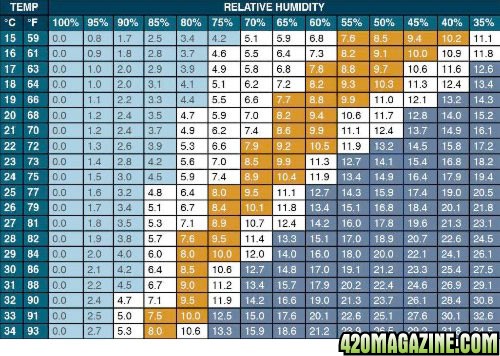Islandgrow
Well-Known Member
Here is something on it from another site has more info so you can google . Essentialy if the plant doesn't transpire it doesn't take up fluids. So no nutes uptaken. The Effect of Relative Humidity on Your Plants.>>>>>>>>>I'm trying to think of a more intelligent way to put this but... I don't know what the numbers in the main block mean.
RH can be easily measured using digital or analogue meters called "hygrometers." They are available for around $15 at your local indoor gardening store. But what do the readings mean for your plants?
Turns out-they mean a great deal! While many novice growers focus solely on keeping temperature in range, many take their eye off the ball as far as RH is concerned-perhaps because they don't fully understand what it is or how to manipulate it to their advantage.
Have you ever been to Florida in July? You'll know that it's not just the heat that's oppressive, it's the humidity! You feel constantly wet with sweat - the whole place feels like a sauna you can't escape from! (Sorry Floridians!)
RH has an ever more direct effect on plants. Plants need to "sweat" too - or rather, they need to transpire (release water vapor through their stomata) in order to grow.
The amount of water plants lose through transpiration is regulated, to a point, by opening and closing their stomata. However, as a general rule, the drier the air, the more plants will transpire.
Under Pressure
All gasses in the air exert a certain "pressure." The more water vapor in the air the greater the vapor pressure. What does this mean? Well, in high RH conditions (think of Florida again) there is a greater vapor pressure being exerted on plants than in low RH conditions. From a plant's perspective, high vapor pressure can be thought of as an unseen force in the air pushing on the plants from all directions. This pressure is exerted onto the leaves by the high concentration of water vapor in the air making it harder for the plant to 'push back' by losing water into the air by transpiration. This is why with high RH plants transpire less. Conversely, in environments with low RH, only a small amount of pressure is exerted on the plants' leaves, making it easy for them to lose water into the air.
"carpe diem"




 state probably becomes painfully evident...
state probably becomes painfully evident...



 It's sometimes hard to grasp what a climate with essentially no free water vapor is like. You can warm that stuff up, but there's no moisture in it!
It's sometimes hard to grasp what a climate with essentially no free water vapor is like. You can warm that stuff up, but there's no moisture in it! 
 we will have to do some checking around on these, not sure if they have different size packets or only one size. I think I remember seeing them in a few different humidity levels but that may not be the case. Lol the old memory isn't as good as it use to be. We did order a packet of them and have them in with some of our Jared up buds, want to say they were 62%??
we will have to do some checking around on these, not sure if they have different size packets or only one size. I think I remember seeing them in a few different humidity levels but that may not be the case. Lol the old memory isn't as good as it use to be. We did order a packet of them and have them in with some of our Jared up buds, want to say they were 62%?? 